Milan has Prada, New York has Thom Browne, Paris has everyone. London is a fashion week made infamous by outsiders who in the last ten years have been forced by a lack of support to either skip the week, produce a cheaper digital lookbook, or flee to Paris. Jonathan Anderson, Wales Bonner, and Kiko Kostadinov show there, Simone Rocha visits on occasion, and Martine Rose and Vivienne Westwood now show off schedule or digitally.
This leaves an underfunded, antsy, gutsy class of the UK (and the world’s) most cohesive class of rising indie designers.
And Burberry.
Burberry is a cash cow, the flashy light that brings the celebrities and the media to London, giving the less tolerant or interesting an excuse to come across the pond. This year, people seemed to think it was worth the trip.
Daniel Lee’s Burberry FW25 collection was dark, sexy, big budget capital F Fashion. Voluptuous coats were styled edgily alongside deep velvets and paisleys a la YSL or modern Dries. Alexandra Hildreth, on the other hand, saw the references more as a “colorized Ann Demeulemeester,” a far cry from Burberry’s usual commerciality. The show took on a now familiar tone of swan song - a moody “you’ll miss me when I’m gone” from a Jil Sander bound(?) Daniel Lee to one of the heritage houses struggling the most amidst luxury slowdown and constant creative turnaround.
Burberry is one of many old labels with a specialty legacy luxury good that was forced to transform into a corporation - perhaps at a scale the business was never meant to sustain. Lee’s designs, while enjoyable to some, have not found the mass appeal needed to buoy the brand, and this season shows that a Lee greatest hits edition does not a riveting new fantasy make.
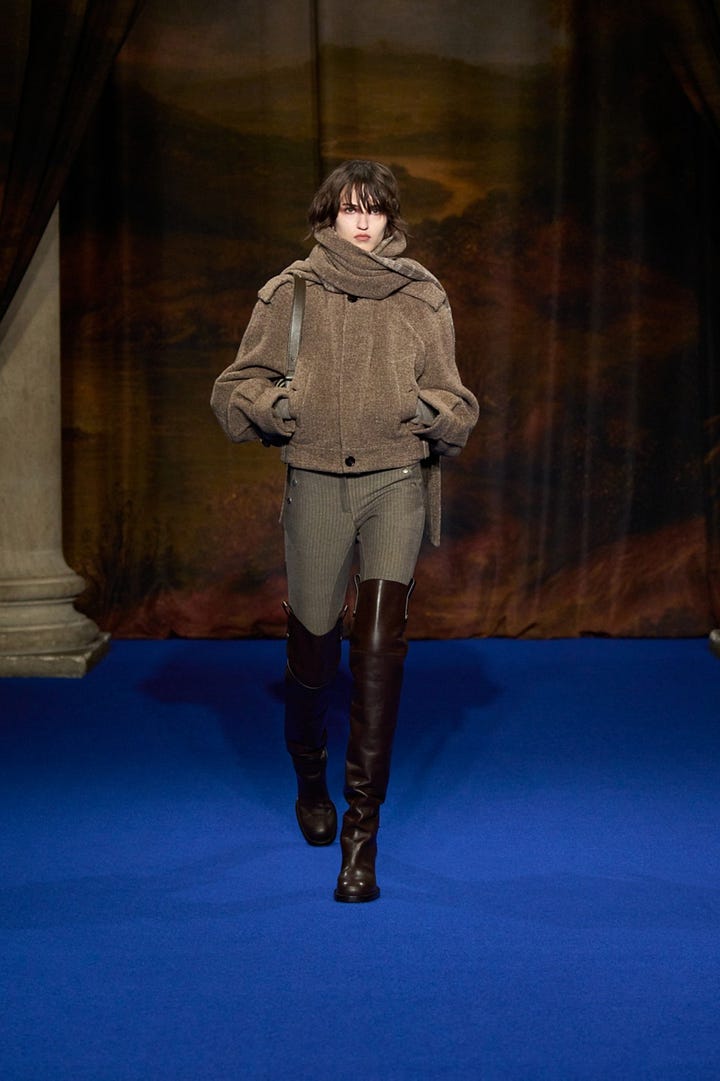
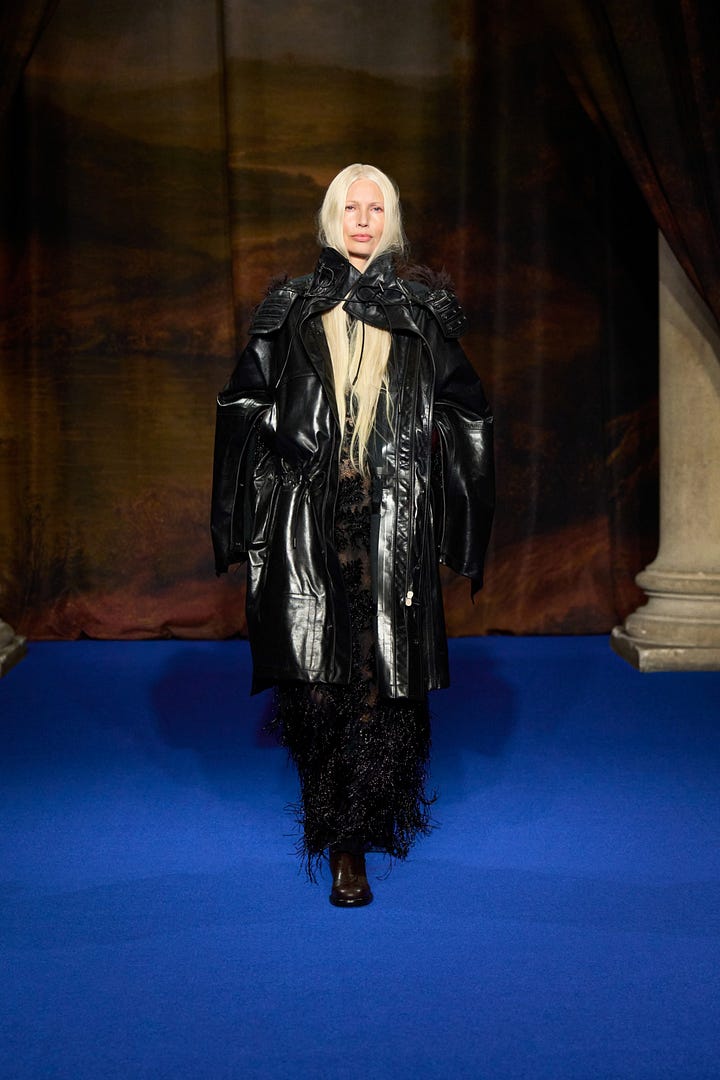
Ryan Yip suggests that the “problem” with Burberry is its static product/symbol, here the Burberry tartan. Each creative director is either forced to replicate or remove. In other words, tread water or erase the fundamental symbol of the house. However, heritage mega-brands trudge on because of the foggy idea that there is an art to the reinterpretation of a house’s symbols/world/character. The tartan is as blank a slate as the Bottega green Lee revived in 2021, the Louis Vuitton monogram, or the Dior Lady bag.
Whether these symbols/products are “good“ is irrelevant, they are long-lasting and thus marketable. But Yip writes “I fail to remember Burberry’s relevance outside of its iconic pattern,” a serious issue for the lifeblood of any luxury symbol.
The Demeulemeester edginess of Burberry FW25 seems studied, put on, and disconnected from any concrete identity, possibly because Lee was so disinterested in finding one in the first place. Lee’s complete disinterest in Burberry, his strategy of making house codes so abstract that Lee’s personal codes can replace them, are what give the show a vindictive edge. These are “simple, beautiful clothes unmarred by the “hype” of Burberry, but unlike his talented forebears of unsuccessful luxury, Lee’s vision is not moored in any concrete character, context, or vision.
The show reminded me of Khaite FW25, which had a New York iteration of the same symptoms: showing a collection “inspired by David Lynch” composed of The Row knockoffs. This is what befuddled me about those gushing that Khaite’s FW25 clothes “were aspirational—you wanted to be that girl.” What girl was discernible behind the layers of imitation and vague contextless references? I am confounded by the idea of, in 2025, a Khaite girl distinct from an Altuzarra girl, distinct from a Toteme girl and so on - none of them are rich enough or care enough to be The Row girls, and even that aspirational cult may only be a minimalist by virtue of laziness.
The only difference with the equally hodge-podge identity-less Burberry is its insistence that the same strategy can be a sort of heartfelt goodbye or articulation of worth. As many have pointed out, Lee hasn’t announced his desire to leave Burberry (yet) and even seemed to spitefully strike at the rumor mill as much as Burberry investors by gushing about how happy he was at the house.
There is so little that necessitates these 60 looks, and yet it seems to think of itself as novel, varied, the peak of a fantasy that is still inarticulate. Burberry is ultimately guilty of Cathy Horyn’s NYFW gripe: it is rootless, contextless, and therefore forgettable. The only sliver Lee provides about the show’s direction is Saltburn, a connection that is as baffling as it is invisible. The characters in Saltburn are upper-crust Brits, but these Burberry characters seem only to be moody Brits. There is no sense of an intrinsic, specific Burberry girl.
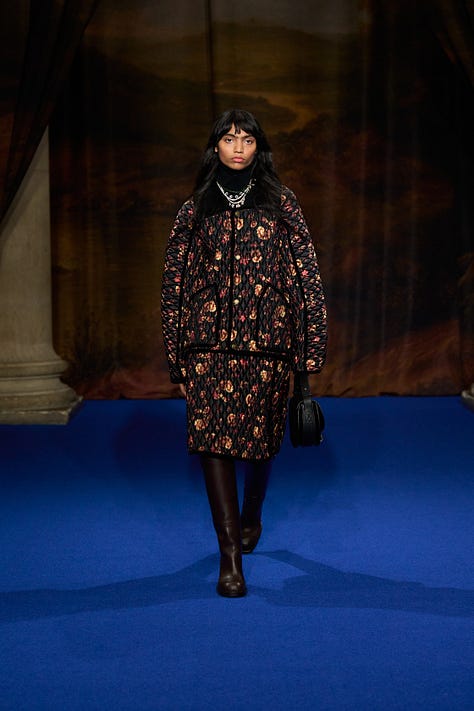


A much better reason to watch London were Dilaria Findikoglu and Paulo Carzana, who showed at cramped clubs and historical pubs, comparatively at 31 and 14 looks respectively.
Paolo Carzana used wildly colorful treated and naturally dyed fabrics that twisted and cinched and layered to form a bright peasantish dress code. Grounding the far off logic of these thin crinkled layers and droopy hats was the cramped and storied Holy Tavern in Clerkenwell, and Carzana’s description of the show as about society approaching “its own self destruction.” Titled “Dragons Unwinged at the Butchers Block” could also point to the colorful drapes and twists as the veggie-technicolor guts of ancient mystery. We must make something beautiful out of killing the fantastical.


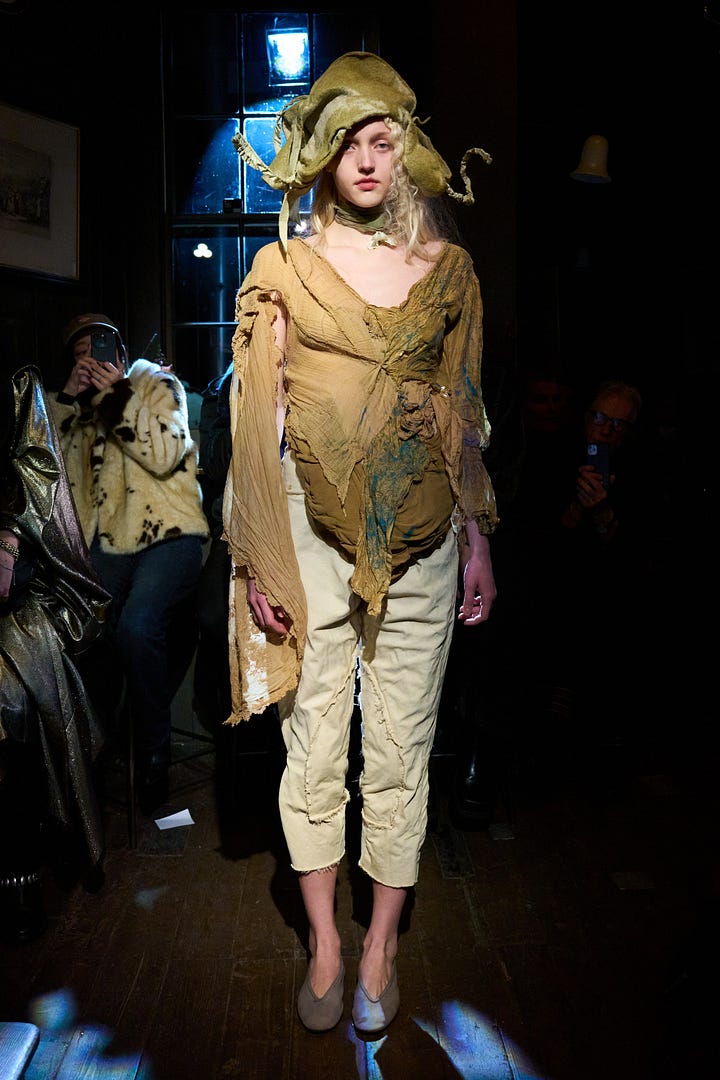
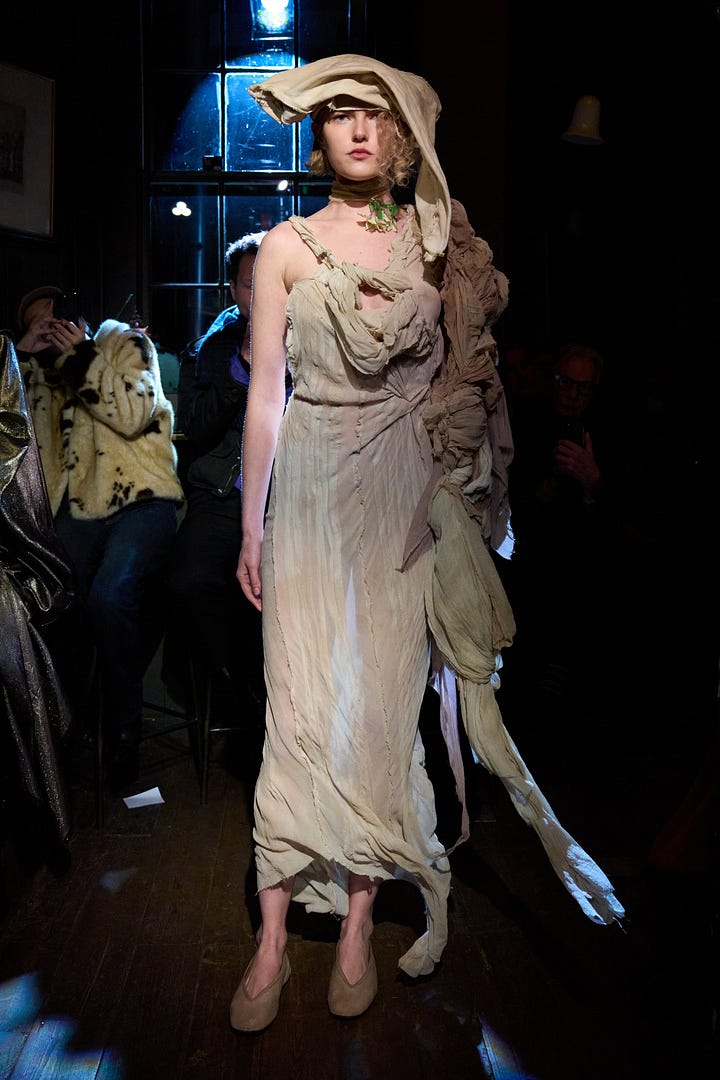
This concept is perhaps taken literally by Dilara Findikoglu, who adorned nude, skintight, or chiffon draped looks with bones, teeth, shells, and hair. There were latex dresses tattooed on red, deliriously tight corsets, long red hairdos that merged with embroidery on sheer tops. It was titled “Venus in Chaos” and described as “about finding beauty through destruction.” Like Carzana, destruction becomes impetus for creation, a way of warping and reconstructing various idealized or intrinsic femininity. The girl in the half pearl becomes vaguely tribal, the formal gown tattered and open, long Rapunzel locks ensnare the body until another look shows it subsuming it in a jacket of braids. My favorite look may still be the scarlet crushed velvet jacket over unzipped leather trousers, dirty black Converse, and a messy maroon lip. Domineering, sexy, brilliantly executed classicism made modern via extremity.
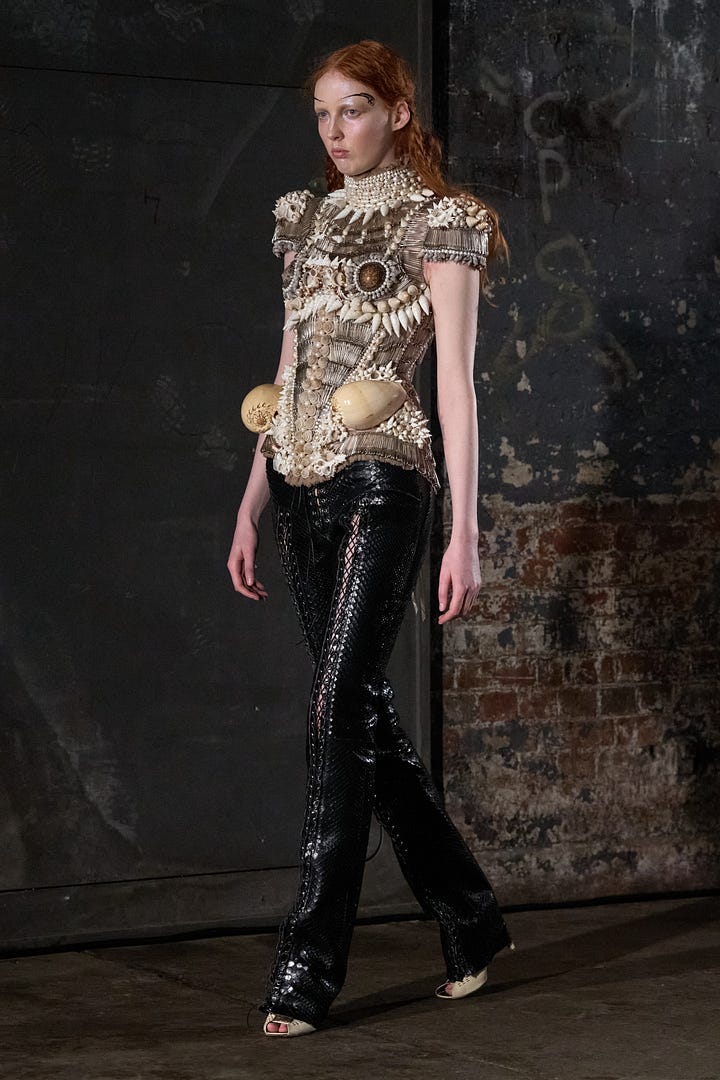



Because so much of Carzana and Findikoglu’s work relies on the handmade, on creating communal and tight knit runway spaces, and on rejecting/offending traditional sales models, the two are often compared to Alexander McQueen. Cathy Horyn made this comparison, yet wrote (specifically of Findikoglu) “only he did them better and with artistic context.“
Whenever this kind of sentiment arises, I wonder why I never hear it used around successful Maria Grazia Chiuri Dior shows (one of her best seasons in years was also a Demeulemeester rip off), Vaccarello’s emptier YSL lookbooks, Pharrell’s derivative LV shows, or for that matter, Burberry! These shows are babied, their creative directors haplessly bound to their investors and forced into mediocrity. What the lumbering giants lack in good clothing often is made up by razzle dazzle set design, and spectacles that are deemed worthy comparative to indie oddity - which is always a Margiela or Mcqueen rip off or some other complaint. The bar is always set impossibly high for those with little to nothing.
The greatest benefit of such wild, uncompromising work has been celebrity dressing - celebrities like Charli XCX, Julia Fox, and others wore Findikogluat the Oscars & Brit Awards not more than two weeks after her show. Otherwise, there’s very little designers like this can do to sell their work in any mass or profitable scale. They face a hyper saturated market mainly unconcerned with craft or art, which was not the case in the time of McQueen.
Even when critics invoke the aesthetic similarities between the sweetly nostalgic last G*lliano-Margiela Artisinal show and Carzana/Findikoglu the vast disparity of resources between the two should be noted, as should the far fewer rewards for such risks. This must be central to understanding and contrasting the work of a giant like a Burberry/Margiela with small artists producing with and ultimately generating little money. One may be “fashion,” yet increasingly irrelevant. The other is relevant, yet alienated from fashion.
Each kind of show has its merits but I will say this: as fashion refuses a questioning of its existence/production mode amid extinction level climate crisis, the show that uses less to create more is certainly worthy of heftier praise even if it is “not as good” as fashion’s most celebrated designer.
There was far less backhanded praise for Tolu Coker, possibly because she invests as much into her vivid sets as her garments. Tolu Coker FW25 was a continuation of Coker’s domestic Windrush generation time capsules, a love letter to Black Britain by way of saturated colors, wonderfully tailored shirt dresses, and oversized suiting. The show was titled Ori, (head in Yoruba) explained by Coker as “a metaphysical concept regarding birthright and everything which is birthed from one’s aura, self or soul.” The room was blood red, models held cotton and rosaries, Nina Simone’s “Strange Fruit“ played.

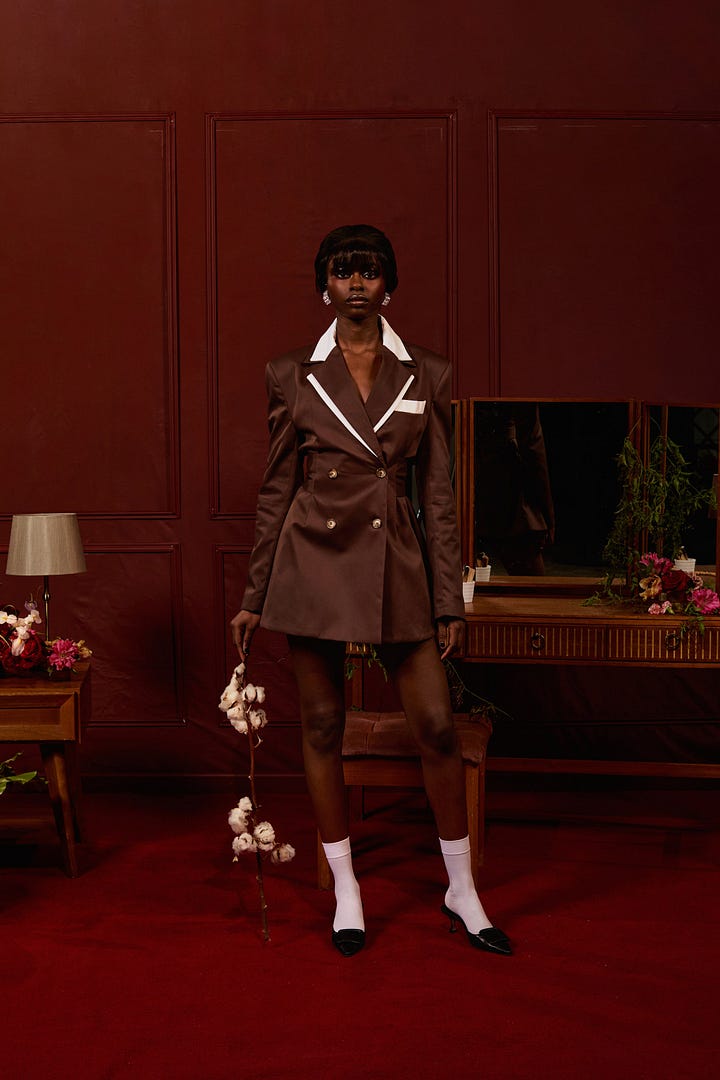

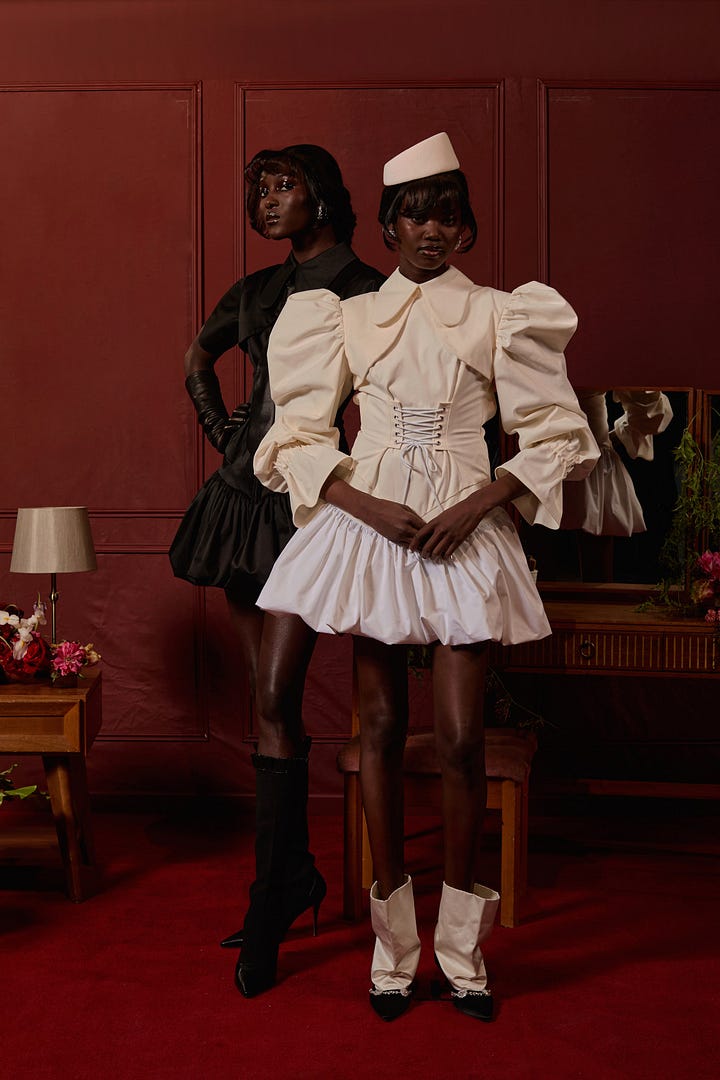
Coker is a fascinating designer to study as a compromise between the radical anti-consumer craft focus of Carzana/Findikoglu and the declared pragmatism and heritage of a Burberry. One could wear Coker’s work easily. It is storied, “classic“ in a sense, yet still tinged with the unexpected. Coker explains that “a lot of what I do really leans into British heritage. The thing is, general perceptions of Britishness rarely take migration into context.” What Coker achieves is a sense of British locality and character that refuses assimilation or homogenization. Coker’s fantasies are specific, articulate, and unapologetically niche.
London Fashion Week, is a globalized indie city. Designers around the world study and root themselves in London before selling and showing to the world market. Even the most definably English aesthete (cough cough, Burberry) must speak as much if not more to global demands rather than locality. London’s most successful, Westwood/Mcqueen and more recently Wales Bonner and Martine Rose, become globally regarded because of a dedication to sticking with and inverting local English fantasies, histories, and narratives. Coker is carrying on that torch of unique and local fashion storytelling.
For all the talk of a London Fashion Week without big tentpole brands and diminishing exposure, the city is an embarrassment of indie riches. There is someone for everybody, there is an artist in the wings crafting Victorian era waistcoats from veggie dyed linen, another creating street ready puffers in alien shapes, another besting Paris’ best funded coutouriers with sumptuous lookbooks of perfect tulle dresses.
The only worry is that there will never be enough eyes, enough open wallets, enough government support to sustain this ecosystem. Still, it offers a hopeful prophecy of toppled titans and brilliant, local, lovingly crafted art.




